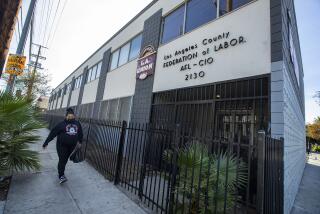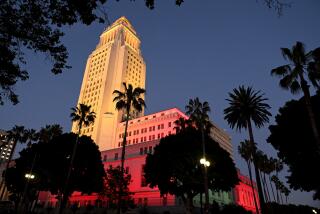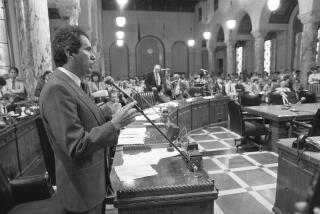Public Corruption, L.A.-Style: Where Have the Notorious Gone?
Throughout the first half of this century, it was the firm desire of the oligarchy who ran Los Angeles that news of local corruption and scandal be studiously ignored, or written about so obliquely that it took a decoder to decipher a story. Bad news was bad for business. Bad for growth and land speculation. Wasn’t that, after all, what Los Angeles was then all about?
The self-designated “white spot” of urban America, clean of eastern-style corruption, was the image that city fathers wanted to project to Wall Street bankers and Midwest, middle-class immigrants ready to invest their savings. With remarkable resolve and astonishing success, they achieved their goal.
So much so, in fact, that when serious allegations of corruption swirl around a powerful local politician, as they are around City Councilman Richard Alatorre, people tend to react as if a rarely seen stranger is paying a visit.
New York’s and Chicago’s corruption scandals, on the other hand, have deeply defined those cities and become part of their folklore. In New York City, names are shorthand for scandalous eras: Boss Tweed and Tammany Hall for the mid-and-late 19th century; Mayor Jimmy Walker for the 1920s and early ‘30s; Frank Serpico for the late ‘60s, and, for the mid-’80s, (Stanley M.) Friedman and (Donald) Manes, the former the bribe-taking, contract-fixing Bronx Democratic Party chairman, the latter, the similarly guilty Queens Borough president.
Chicago’s denizens are legend, too, from Al Capone and George “Bugs” Moran buying off most of the Chicago Police Department in the 1920s, through the federal corruption indictments, in the mid-’80s, of almost 250 local officials, including cops, judges, city council members and state legislators.
But L.A.’s more notorious ghosts have simply vanished. It’s as if the relatively clean city government Los Angeles now enjoys emerged full-blown from some air-tight vacuum pack. Yet, the city’s rigid Civil Service protections, its commission system, its powerful City Council and weak mayoral office are all a direct result of the massive, systemic corruption that brought down L.A. mayors and police chiefs from the beginning of this century straight through to 1950.
Forgetting this history is a big mistake. A blind belief in self-congratulatory civic myths can lead to smug complacency. For example, during the 1980s and right up to the moment when Rodney G. King was beaten, the Los Angeles Police Department was touted by the city’s establishment as the world’s best, cutting-edge police force--with disastrous results.
That’s why it is worth examining the questions being raised about Alatorre’s various financial dealings and his conduct while a board member of the Metropolitan Transit Authority, and placing them in a historical context. Currently, almost a half-dozen law-enforcement agencies are investigating these matters. Such investigations of public officials have historical echoes.
During the early 1920s, for example, L.A. mayors, district attorneys and city councilmen took campaign money from madams, bootleggers and gamblers. The LAPD’s Central Vice Squad was on the take; and a loose, organized-crime syndicate was protected by the top aide of Mayor George Cryer. It wasn’t violent, big-time, high-profile, Chicago-style organized crime. But its corrupting influence was just as real.
By the mid-’20s, Jack Dragna and John Rosselli, men with eastern Mafia connections, were engaged in a sometimes bloody rivalry with the home-grown, City Hall-approved Charlie Crawford for control of bootlegging turf. They also were setting up a West Coast outpost for the mob’s nationwide horse-racing wire service.
Then, in 1933, Frank Shaw was elected mayor. He quickly took public corruption to a new, higher level, instituting what the socialist journalist and political activist Reuben Borough called the “Shaw spoils system.” City contracts were awarded without competitive bidding, people in city government were paid to use designated contractors, and large industries were solicited for bribes in return for the Shaw administration’s sponsoring of legislation designed to drive their smaller competitors out of business. Meanwhile, Frank’s brother, Joe, was selling LAPD jobs, the answer keys to exams and hard-to-get, Depression-era promotions, right out of his City Hall office.
Simultaneously, the LAPD’s Central Vice Squad roamed the city, serving as the ultimate enforcer and collector of organized vice operations, with the take going all the way up the line to the central organizer, Joe Shaw.
In 1937, the general situation was summed up by citizen activist Clifford Clinton and other reformers. They wrote in the minority report of the grand jury on which they served that: “A portion of the underworld profits have been used in financing campaigns [of] . . . city and county officials in vital positions . . . [While] the district attorney’s office, sheriff’s office, and Los Angeles Police Department work in complete harmony and never interfere with . . . important figures in the underworld.”
It took the square-jawed courage of Clinton, the prodding decency of Superior Court Judge (and future Los Angeles Mayor) Fletcher Bowron, and the gritty tenacity of the hard-eyed, ex-LAPD-detective-turned-private-eye Harry Raymond to expose the corruption. In doing so, they made the LAPD’s Intelligence Squad so desperate to shut them up that it blew up Raymond’s car, riddling his body with wounds that nearly killed him. The bombing so outraged the public that they voted Shaw out of office in one of the first recalls of a big-city mayor in U.S. history. The head of the LAPD’s Intelligence Squad, who was working directly out of the mayor’s office, was sentenced to two years to life in San Quentin for the bombing. In the months that followed, Chief of Police James Edgar Davis and 23 other high-ranking LAPD officers submitted forced resignations.
The Intelligence Squad had also spied on anyone even remotely critical of the police department, from the crusading liberal journalist and editor Carey McWilliams through the dour, conservative Bowron. The list included the district attorney and two of the five members of the county Board of Supervisors.
In the early 80s, the LAPD again got caught spying, this time on more than 200 organizations and individuals, while simultaneously infiltrating meetings of the City Council and private meetings attended by Mayor Tom Bradley. In the twilight of his 20 years as mayor, Bradley himself faced allegations of political venality. Some proved true.
Perhaps Bradley had stayed in the same office, critically unexamined and unchallenged too long. It’s hard to imagine the young Bradley, the proud LAPD lieutenant, the courageous council member, the inspiring, idealistic mayor, picking up the phone, as he did late in his career, and calling the city treasurer, after which $2 million in city funds was deposited in a bank that had paid Bradley $18,000 the previous year as an advisor; or to fathom his failure to disclose more than $200,000 in investments and having to pay a $20,000 settlement penalty; or to think his name would ever be linked to Michael Milken; or to believe his staff and commissioners solicited fund-raising money from groups and people often doing business with the city. Those, among others, were the political sins of Bradley. Like his great political ally, California’s former U.S. Sen. Alan Cranston, he paid for them with the tarnishing of his name and the denigration of his achievements.
Much has changed since Los Angeles was the “white spot.” The charter reforms that proved a debacle when a powerless Bradley was unable to fire defiant Police Chief Daryl F. Gates following the King beating, have worked particularly well in thwarting corruption.
Moreover, the local press is now unmuzzled and has broken many stories in recent years. And, as politicians well know, the press isn’t the only institution watching. Federal legislation, such as the 1984 Comprehensive Crime Control Act, has given ambitious U.S. attorneys tremendous powers of investigation.
We don’t yet know if Allatorre has done anything illegal, or if others may be involved. But it’s a pretty safe bet that any tentacles that may exist into city government are limited.


